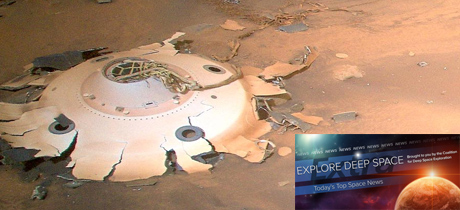In Today’s Deep Space Extra… Four U.S. and European astronauts successfully reached the International Space Station on Wednesday evening. Lunar backpack could aid Artemis explorers. James Webb Space Telescope close to its coldest temperature.
Human Space Exploration
Four astronauts arrive at Space Station for long-term stay
Coalition Members in the News – Axiom Space, Boeing
Spaceflightnow.com (4/27): NASA’s Crew-4 astronauts docked autonomously with the International Space Station (ISS) on Wednesday at 7:37 p.m. EDT, just under 16 hours after lifting off from NASA’s Kennedy Space Center (KSC). The transit was the fastest launch to docking with the orbital lab by a U.S. spacecraft so far. The Crew-4 Dragon astronauts, Kjell Lindgren, Bob Hines and Jessica Watkins, all from NASA, and the European Space Agency’s (ESA) Samantha Cristoforetti, are replacements for NASA’s Raja Chari, Tom Marshburn and Kayla Barron, and ESA’s Matthias Maurer. They are to return to Earth aboard the Crew-3 Dragon next week, if the weather in the splashdown zones off the Florida coast permits. The Crew-3 quartet launched and docked over November 10 and 11.
This NASA ‘lunar backpack’ will help Artemis astronauts explore the Moon
Space.com (4/27): NASA has developed the Kinematic Navigation and Cartography Knapsack (KNaCK), an accessory that will use light detection and ranging laser light to develop 3-D maps of the Moon’s surface with centimeter resolution while worn as a knapsack by Artemis astronauts as they carry out mission activities. Due to low levels of lighting at the lunar south pole, the site of a planned NASA lunar base, lidar is expected to be a valuable asset. Given the absence of a lunar GPS system, KNaCK promises to place local surface features in a geological context with larger, better known features to contribute to astronaut safety.
Space Science
Ingenuity helicopter flies over leftover wreckage from Mars landing last year
Spaceflightnow.com (4/27): During its most recent flight on Mars, on April 19, NASA’s Ingenuity drone helicopter captured imagery of the parachute and parts of the aeroshell that helped to successfully deliver the Perseverance rover and Ingenuity to the surface of Jezero Crater on February 18, 2021. Mission engineers will assess the imagery to better gauge the performance of the parachute and the aeroshell that are essential to slowing spacecraft entering the thin Martian atmosphere in order to land. Originally a flight test vehicle, Ingenuity is now providing valuable reconnaissance for Perseverance as the rover collects samples of Martian rock and soil from a stream delta that are to be returned to Earth. Once on Earth, scientists will study the materials for possible evidence of past biological activity on Mars.
Webb has almost reached its final, coldest temperature
Universetoday.com (4/27): In order to achieve its observation goals, NASA’s James Webb Space Telescope (JWST), which was launched on December 25, 2021, must bring its sensors to extremely low temperatures, actually near absolute zero. Now at the L2 Lagrange point, or about 1 million miles from Earth, the new space observatory continues to make good progress in achieving its thermal objectives. Scientific observations could get underway in about a month.
Opinion
How the U.S. can lead in the ‘Space Century’
The Hill (4/27): Leadership in space over the coming century could hold the key to the future of the Earth, writes Mark R. Kennedy, a global fellow at the Wilson Center for International Scholars and a former member of Congress from Minnesota. He asserts global powers have entered a “Space Century.” “For America to continue to lead, it must prioritize funding support for NASA and Space Force as they continue to nurture international, commercial and academic partnerships,” according to Kennedy. The civil exploration of space, led by a new race to the Moon between the U.S. and China, becomes a significant factor in a broader race to establish a technical supremacy important to national security and take a lead in a “burgeoning” space economy, Kennedy explains.
Other News
NOAA’S Office of Space Commerce gets new director, Elevated Position
Spacepolicyonline.com (4/27): Richard DalBello, a 30-year veteran of the space field, has been named director of the Office of Space Commerce (OSC), effective May 9. The post will be elevated to a higher level within NOAA as recommended by the U.S. Senate Appropriations Committee and others, Commerce Secretary Gina Raimondo announced Wednesday. She made the announcement during a Senate Commerce, Science, and Transportation Committee hearing on the Department’s FY2023 budget request, which seeks to increase the OSC line from $16 million to $87.7 million. DalBello will lead efforts to make OSC responsible for civil Space Situational Awareness and Space Traffic Management, duties that have been shouldered by the Department of Defense (DoD), which will retain those responsibilities for military satellite operations.

